MasterChef champ Sashi Cheliah reveals the secrets of cooking with spice at home
ADELAIDE prison guard Sashi Cheliah won the MasterChef title with his methodical approach and delicious, spice-laden Indian and Malay creations. Here, he shares the secrets of cooking with spice at home. SEE SASHI’S RECIPES
HE survived the most daunting of challenges, from replicating the devilishly complex dishes of high-profile chefs to feeding a crowd of hungry firefighters and even preparing canapés for HRH Prince Charles.
Today, however, MasterChef champ Sashi Cheliah’s methodical approach and apparently endless supply of patience is being put to a test of a different kind as he reprises one of his winning dishes with help from his family.
Like any good MasterChef cook, everything is happening at once. Wife Rabicca is wrestling with a blender filled with a herb and ginger marinade. Marcus, 12, is toasting coconut shreds in a hot pan. Ryan, 10, is chopping coriander and mint leaves, while dipping a spoon into anything that looks like it needs tasting, a good habit he has clearly picked up from his dad.
Sashi, meanwhile, is directing traffic in his calm, reassuring voice, at the same time as portioning fillets of fish, preparing the skin to be roasted and crisped, keeping the benches clean and each component in its place.
It is a reminder of what drove Sashi to the kitchen in the first place, when he was working in a prison, and the praise that counted was not from Gary, George and Matt but his own family.
“Food was more a stress relief from work,” he recalls.
“When I came home how I removed myself from work was to focus on cooking a delicious meal for my family.
“I would take an hour or an hour and a half to cook for my wife and children, then we will have a great dinner and have a chat.”
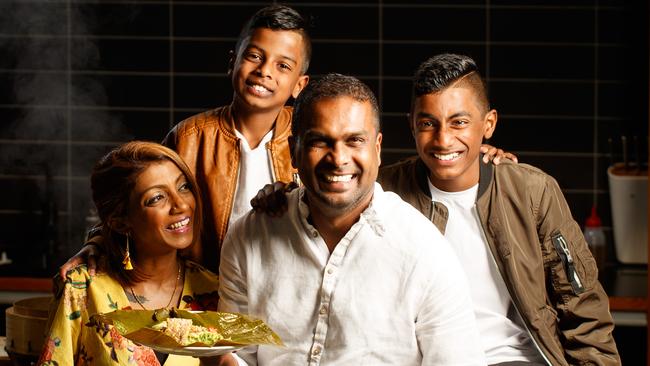
Dream come true
The past year has seen Sashi’s world turned upside-down. After being convinced to audition for MasterChef by Rabicca, the spice-laden, Indian and Malay dishes inspired by memories of his childhood in Singapore quickly made him a favourite with the judges.
He also showed the value of a methodical approach, right through to the grand final when he won with a record score.
Sashi isn’t wasting any time in using the financial backing and profile that come with the title to fulfil his dream.
The morning after our interview he is packing up the family and leaving his home in Adelaide for a six-month stay in Melbourne, where he will open “Gaja by Sashi”, a pop-up eatery in the CBD.
He also plans to spend time in Sydney, before returning to his home town to establish a more permanent venue.
“Before I was working as a manager in the prisons, now I’m going to be travelling around cooking for everyone,” he says, shaking his head.
“Gaja will be a mix of Malay, Chinese and Indian … but it isn’t going to be a fusion, more a mix of different cultures.”
For the most part, this is also the style of cooking that Sashi favours at home where he uses passed down by his mother and aunties, who he watched in the kitchen when he was growing up.
While the presentation might have been a little flasher, the chicken lemak, fish curry and sambal beans he did for the show were perfected at home.

Mystery box
Like most Australian households, however, Sashi’s weeknight menu can be varied.
“We will cook a mixture of everything depending on our mood on the day,” he says. “Generally we eat Indian and Malay food but there will be times when we feel like having pasta, or steak or roast. Whatever my wife and kids feel like having, I will cook”
Sashi also emphasises the importance of being flexible and using whatever food is available — a skill that served him well in the show.
“On some occasions it is a mystery box in our house,” he says.
“I finish work at 5pm and there is no time then to go to the market and buy food. Whatever I can find in the fridge or the pantry is what will end up on the table. Maybe that’s why I did well in those challenges.”
Rice, naturally, is a staple in the house, along with a curry sauce that could have a base of lentils (dal), tomato and tamarind (rasam) or coconut milk, as in the Malay-style lemak.
“I am very particular about a balanced diet for the kids … they must have carbs, proteins and vegetables. I like to use a lot of white meat, mainly fish and chicken, and keep red meat to once or twice a week. We will also have prawns every week.”
Sashi doesn’t like his vegetables to be mushy so leaves them out of a curry or adds them in for the last five or 10 minutes. More often he prepares them separately, tossed in a wok with oyster sauce or sesame oil.
Master class
Sashi says his MasterChef experience quickly taught him to be more organised in the kitchen. “Organise your ingredients and put everything away as it is used,” he advises.
“If you had seen my first episode in the audition and my last episode I have travelled a long way as far as cleanliness. But I do miss the guys who wash up plates for us. The whole place is spotless after we finish.”
He also highlights the importance of tasting everything you cook.
“Ingredients can have different qualities that effect the flavour,” he says.
“Every time you cook it will be different. And flavours need to develop at different stages — at one stage it will need a bit more sugar, at the next stage a bit more salt …”
Sashi’s sons, Marcus and Ryan, have learnt to fend for themselves in the kitchen and can cook themselves bacon and eggs, pancakes and other simple meals. They are also good at chopping herbs and other knife skills.
The secret, Sashi says, is to put aside some of the usual parental concerns.
“Let them try out stuff in the kitchen. Don’t be afraid and stop them from trying things and being experimental. We have to trust them and teach them responsibility in handling a flame and a sharp blade. With coaching and mentoring, they should be okay.”
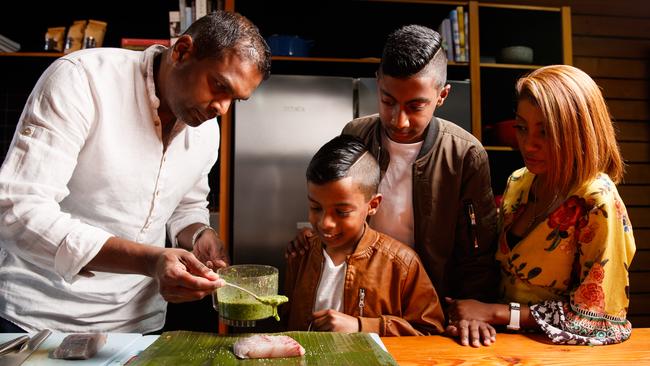
Spice of life
For Sashi, cooking without spice would be like an artist working without paint.
They add colour and flavour that turn simple stews, grills, rice dishes and even desserts into something special.
“Spice is a very quick way to add flavour to food,” he says.
“Some stocks and broths can take hours and hours to develop flavours, whereas spices are an instant flavour amplifier. Put them in and you can get a result very quickly … though if you want to develop a deeper, stronger flavour you can cook for a longer time.
“My favourite spices are cinnamon, star anise, cloves, coriander and cardamom. But there are tons of them to play with.”
For a basic curry mix, combine coriander, cumin, turmeric and chilli, followed by a sprinkle of garam masala blend later in the cooking.
“Then as you go deeper into other curries, that is where the cardamom, cloves, fennel, fenugreek and other spices will come in,” Sashi says.
Spices can also be used in different ways, sometimes in the same dish to increase its complexity.
For his lamb with pea puree and curry sauce, for instance, a similar spice mix is rubbed into the meat, used as the base for the sauce and even fried with the broccoli and brussels sprouts.
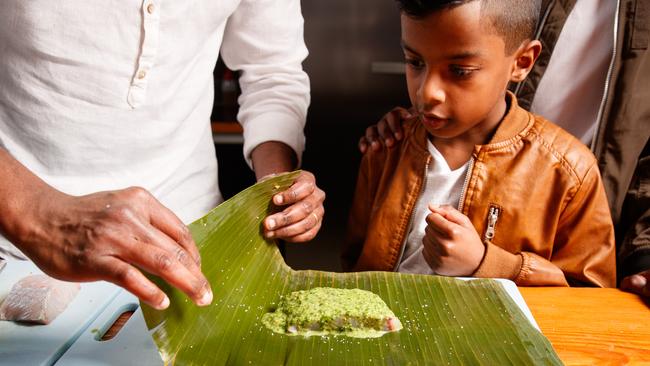
Take it easy
In an ideal world, all spices would be roasted whole and freshly ground. But, says Sashi, when time is limited, he is happy to take a shortcut.
“To be frank, I’m a bit lazy at home,” he says.
“I don’t roast my spices. I often go for instant curry powders. They can work very well at home for people who are struggling to cook a curry. You can get really good results.”
Sashi buys his curry powder and other spices at an Indian grocer near his home but says good products can be found in supermarkets.
He prefers curry powder to paste because it has a better shelf life and it is easier to adjust flavours with dry spices.
Partners in slime
One of Sashi’s favourite vegetables is okra, the slender green pods that react in different ways depending how they are cooked and can divide a crowd with their slimy texture.
“For a fish curry, I like it slimy,” he says. “I just slice off the top and bottom, punch a hole in the centre and drop them in so they soak up the gravy.
“But I also slice them as thin as possible, coat with besan flour mixed with spices like turmeric and chilli, and fry in hot oil for a snack.”
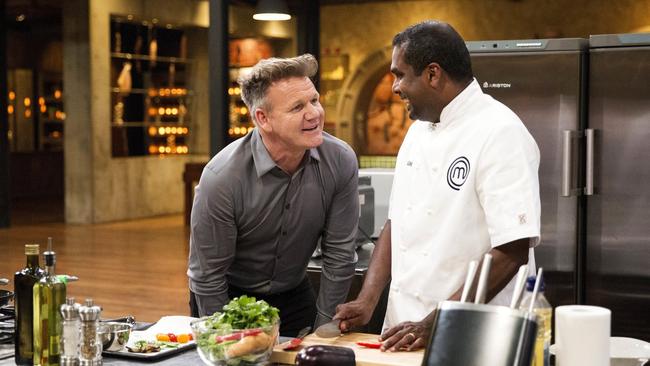
What to drink
Sashi says he enjoys a good beer with a curry, particularly a dark ale from Victorian brewer White Rabbit or Kilkenny from Ireland.
For lamb biryani or other red meat dishes, he will open a bottle of shiraz.
Eating out
When Sashi and Rabicca dine out in Adelaide, there is only one rule. “I don’t really eat Indian food,” Sashi says. “I can cook that myself.”
Some of their favourite restaurants include Africola in the city, Parwana in Torrensville, Utopia at Waterfall Gully, Khim Thai at Prospect and, for the whole family, Jamie’s Italian.
Sashi also has a soft spot for the burger chain Carl’s Jr that he learned to love in Singapore.
For shopping, he heads to Lucky Asian Grocery on Prospect Rd and Indian Plaza on Main North Rd, as well as the Central Market for more obscure ingredients.
RECIPES
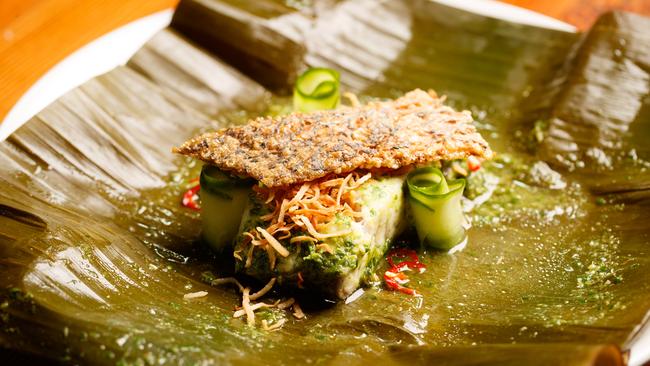
Sashi’s steamed barramundi with ginger and coriander salsa
Serves 4
Pickled Cucumber:
1 cucumber, finely sliced into ribbons
2cm piece ginger, peeled and finely chopped
1 birds eye chilli, finely chopped
4 tbsp sugar
4 tbsp white vinegar
Coriander and Ginger Fish:
800g firm white fish fillet, skin on
½ bunch coriander, leaves picked
½ bunch mint, leaves picked
5cm piece ginger, peeled
Flesh from ½ young coconut
60ml young coconut water
Salt to taste
1-2 banana leaves to wrap
Toasted coconut flakes, reserved picked ginger and chilli, to garnish
FOR PICKLED CUCUMBER
Place all ingredients and 2 tbsp water in a medium bowl and mix to combine. Set aside, in fridge, to pickle for at least 30 minutes. Drain liquid, reserving ginger and chilli for garnish and set aside until serving.
FOR FISH
Preheat oven to 180C.
Remove skin from fish fillet and lay on to a paper-lined baking tray. Sprinkle generously with salt then cover with a sheet of baking paper and another baking tray. Place in the oven to cook until crisp and lightly golden, about 30-35 minutes. Remove from oven, remove top baking tray, and set aside to cool. Break into shards and set aside until serving.
Half fill a wok with water and bring to the boil.
Place coriander leaves, mint leaves, ginger, coconut flesh, coconut water and salt into a food processor and process to a paste.
Cut fish fillet into 4 portions. Cut banana leaves to make 4 pieces large enough to wrap fish. Place fish fillet in the centre of each piece. Season fish fillets with salt and top with paste. Wrap fish in banana leaf to form a parcel.
Place fish parcels in a bamboo steaming basket and place over simmering water. Steam until cooked through, about 8-10 minutes. Remove basket from wok and set aside until serving.
Place a fish parcel in the centre of each serving plate. Add some pickled cucumbers and a shard of skin. Sprinkle with toasted coconut flakes, and reserved pickled ginger and chilli.
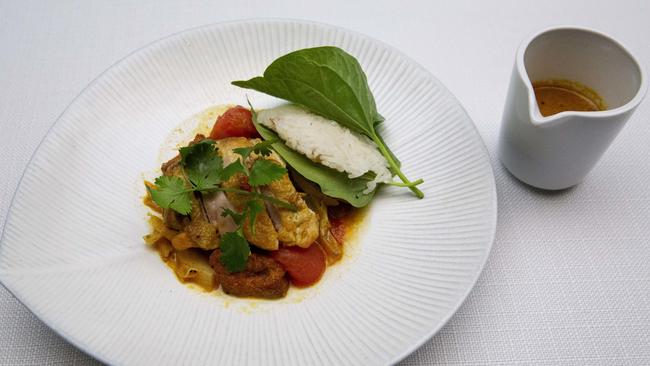
Sashi’s c hicken lemak
Serves 6
Chicken:
3 boneless chicken marylands
2 tsp ground turmeric
Salt
175ml vegetable oil
4 shallots, roughly chopped
3 long red chillies, roughly chopped
2 birdeye chillies, or to taste
5cm fresh ginger
2 cloves garlic
5cm fresh turmeric
1 lemongrass, roughly chopped
50g dried shrimp, soaked in warm water
2 tbsp coconut oil
2 tbsp brown mustard seeds
2 stems curry leaves
5 dried Kashmiri chillies
800ml coconut milk
2 large tomatoes, finely diced
½ small cabbage, roughly chopped
30g tamarind pulp
Juice 1 lime
300g silken firm tofu, cut into 12
Jasmine Rice:
1 cup jasmine rice
3 pandan leaves
3 star anise
1 lemongrass
1 cup coconut milk
Salt
To serve:
Cherry tomatoes
12 betel leaves
Finger lime
Coriander leaves
Preheat oil in deep fryer or deep saucepan to 190C.
For the chicken, cut each maryland into 2 portions and rub with ground turmeric and salt. Cover and set aside in the fridge.
Place a large frying pan over medium heat and add 1 tbsp of oil. Place chicken into the pan, skin side down, and cook until golden. Remove chicken from the pan and set aside on a tray.
For the paste, place shallots, chillies, ginger, garlic, fresh turmeric, lemongrass, dried shrimp, remaining 150ml vegetable oil and 2 tablespoons water into the bowl of a food processor. Process to a smooth paste. Set aside.
Place a large frying pan over low heat. Add coconut oil, mustard seeds and curry leaves.
Once the mustard seeds start to pop, add the dried chillies and cook until fragrant, about 2 minutes.
Add the lemak paste to the frying pan and cook for 15 minutes until softened and lightly golden.
Add coconut milk and cook over low heat for 10 minutes.
Increase heat to medium. Add tomatoes, cabbage and tamarind and simmer for a further 10 minutes.
Add lime juice and season with salt. Add chicken and simmer until chicken is cooked through minutes.
Meanwhile, deep fry tofu in the hot oil until golden brown, about 7 minutes. Drain on kitchen paper and set aside.
For the Jasmine Rice, place ingredients into a medium saucepan along with 1 cup of water and bring to boil.
Reduce the heat to a simmer, cover and cook the rice for 10 minutes. Remove from heat and rest rice for 5 minutes before serving.
To serve, place a large spoonful of cabbage mixture and fried tofu into the middle of each plate and top with a portion of chicken. Add a cherry tomato. Sandwich jasmine rice between two betel leaves and add to the plate.
Top with finger lime pulp and coriander leaves.

